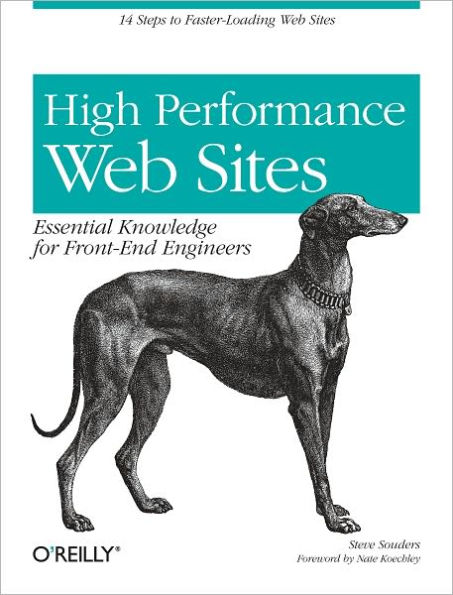
High Performance Web Sites: Essential Knowledge for Front-End Engineers
170
High Performance Web Sites: Essential Knowledge for Front-End Engineers
170eBook
Related collections and offers
Overview
Want your web site to display more quickly? This book presents 14 specific rules that will cut 25% to 50% off response time when users request a page. Author Steve Souders, in his job as Chief Performance Yahoo!, collected these best practices while optimizing some of the most-visited pages on the Web. Even sites that had already been highly optimized, such as Yahoo! Search and the Yahoo! Front Page, were able to benefit from these surprisingly simple performance guidelines.
The rules in High Performance Web Sites explain how you can optimize the performance of the Ajax, CSS, JavaScript, Flash, and images that you've already built into your site -- adjustments that are critical for any rich web application. Other sources of information pay a lot of attention to tuning web servers, databases, and hardware, but the bulk of display time is taken up on the browser side and by the communication between server and browser. High Performance Web Sites covers every aspect of that process.
Each performance rule is supported by specific examples, and code snippets are available on the book's companion web site. The rules include how to:
- Make Fewer HTTP Requests
- Use a Content Delivery Network
- Add an Expires Header
- Gzip Components
- Put Stylesheets at the Top
- Put Scripts at the Bottom
- Avoid CSS Expressions
- Make JavaScript and CSS External
- Reduce DNS Lookups
- Minify JavaScript
- Avoid Redirects
- Remove Duplicates Scripts
- Configure ETags
- Make Ajax Cacheable
If you're building pages for high traffic destinations and want to optimize the experience of users visiting your site, this book is indispensable.
"If everyone would implement just 20% of Steve's guidelines, the Web would be adramatically better place. Between this book and Steve's YSlow extension, there's reallyno excuse for having a sluggish web site anymore."
-Joe Hewitt, Developer of Firebug debugger and Mozilla's DOM Inspector
"Steve Souders has done a fantastic job of distilling a massive, semi-arcane art down to a set of concise, actionable, pragmatic engineering steps that will change the world of web performance."
-Eric Lawrence, Developer of the Fiddler Web Debugger, Microsoft Corporation

Product Details
| ISBN-13: | 9780596550691 |
|---|---|
| Publisher: | O'Reilly Media, Incorporated |
| Publication date: | 09/11/2007 |
| Sold by: | Barnes & Noble |
| Format: | eBook |
| Pages: | 170 |
| File size: | 4 MB |
About the Author
Steve previously worked at Yahoo! as the Chief Performance Yahoo!,
where he blogged about web performance on Yahoo! Developer Network. He was named a Yahoo! Superstar. Steve worked on many of the platforms and products within the company, including running the development team for My Yahoo!. Prior to Yahoo! Steve worked at several small to mid-sized startups including two companies he co-founded, Helix Systems and CoolSync. He also worked at General Magic, WhoWhere?, and Lycos.
Table of Contents
Foreword xi
Preface xiii
The Importance of Frontend Performance 1
Tracking Web Page Performance 1
Where Does the Time Go? 3
The Performance Golden Rule 4
HTTP Overview 6
Compression 7
Conditional GET Requests 7
Expires 8
Keep-Alive 8
There's More 9
Rule 1: Make Fewer HTTP Requests 10
Image Maps 10
CSS Sprites 11
Inline Images 13
Combined Scripts and Stylesheets 15
Conclusion 16
Rule 2: Use a Content Delivery Network 18
Content Delivery Networks 19
The Savings 20
Rule 3: Add an Expires Header 22
Expires Header 22
Max-Age and mod_expires 23
Empty Cache vs. Primed Cache 24
More Than Just Images 25
Revving Filenames 27
Examples 28
Rule 4: Gzip Components 29
How Compression Works 29
What to Compress 30
The Savings 31
Configuration 31
Proxy Caching 33
Edge Cases 34
Gzip in Action 35
Rule 5: Put Stylesheets at the Top 37
Progressive Rendering 37
Sleep.cgi 38
Blank White Screen 39
Flash of Unstyled Content 43
What's a Frontend Engineer to Do? 43
Rule 6: Put Scripts at the Bottom 45
Problems with Scripts 45
Parallel Downloads 46
Scripts Block Downloads 48
Worst Case: Scripts at the Top 49
Best Case: Scripts at the Bottom 49
Putting It in Perspective 50
Rule 7: Avoid CSS Expressions 51
Updating Expressions 52
Working Around the Problem 52
Conclusion 54
Rule 8: Make JavaScript and CSS External 55
Inline vs. External 55
Typical Results in the Field 58
Home Pages 58
The Best of Both Worlds 59
Rule 9: Reduce DNS Lookups 63
DNS Caching and TTLs 63
The Browser's Perspective 66
Reducing DNS Lookups 68
Rule 10: Minify JavaScript 69
Minification 69
Obfuscation 70
The Savings 70
Examples 72
Icing on the Cake 73
Rule 11: Avoid Redirects 76
Types of Redirects 76
How Redirects Hurt Performance 77
Alternatives to Redirects 79
Rule 12: Remove Duplicate Scripts 85
Duplicate Scripts-They Happen 85
Duplicate Scripts Hurt Performance 86
Avoiding Duplicate Scripts 87
Rule 13: Configure ETags 89
What's an ETag? 89
The Problem with ETags 91
ETags: Use 'Em or Lose 'Em 93
ETags in the Real World 94
Rule 14: Make Ajax Cacheable 96
Web 2.0, DHTML, and Ajax 96
Asynchronous = Instantaneous? 98
Optimizing Ajax Requests 99
Caching Ajax in the Real World 99
Deconstructing 10 Top Sites 103
Page Weight, Response Time, YSlow Grade 103
How the Tests Were Done 105
Amazon 107
AOL 110
CNN 114
eBay 116
Google 120
MSN 123
MySpace 127
Wikipedia 130
Yahoo! 132
YouTube 135
Index 139
